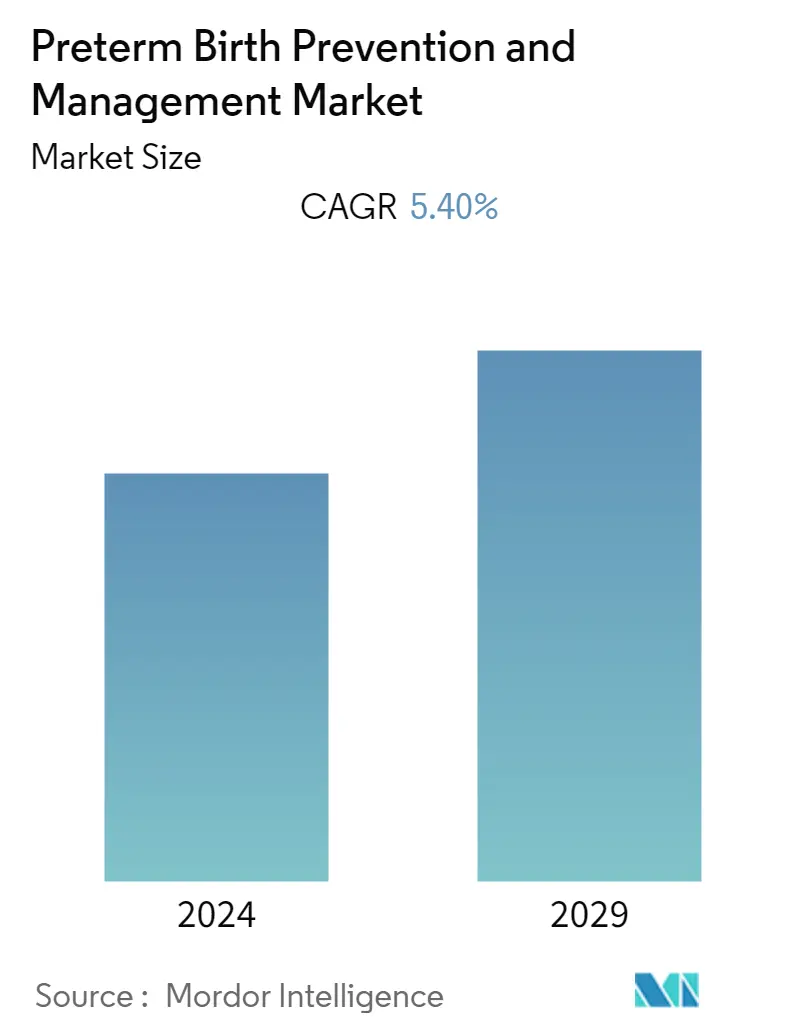Market Size of Preterm Birth Prevention and Management Industry

| Study Period | 2021 - 2029 |
| Base Year For Estimation | 2023 |
| Forecast Data Period | 2024 - 2029 |
| Historical Data Period | 2021 - 2022 |
| CAGR | 5.40 % |
| Fastest Growing Market | Asia Pacific |
| Largest Market | North America |
Major Players
*Disclaimer: Major Players sorted in no particular order |
Preterm Birth Prevention and Management Market Analysis
The preterm birth prevention and management market is expected to register a CAGR of 5.4% over the forecast period.
The COVID-19 pandemic adversely affected treatment and therapies other than COVID-19 since the onset of the outbreak, which significantly impacted the preterm birth prevention and management market. However, preterm birth, premature membrane rupture, and, in rare instances, maternal mortality were among the risks that were heightened by COVID-19 infection during pregnancy. As a result, preterm birth prevention and management therapies were increased to prevent prenatal births and reduce complications. Moreover, in August 2021, a study conducted by researchers at UC San Francisco found that women who contract COVID-19 while pregnant had an increased risk of having any preterm delivery as well as a severe preterm birth. People who had a COVID-19 infection at some point during their pregnancy had a 60% increased risk of having an extreme preterm delivery (birth before 32 weeks) and a 40% increased risk of giving birth before 37 weeks (all preterm births). Preterm birth risk increased by 160% in people who also had COVID-19, hypertension, diabetes, and/or obesity. Another study by the Regents of the University of Minnesota in November 2020 that monitored birth and infant outcomes in 4,442 pregnant women infected with the coronavirus and their 4,527 fetuses and new-borns suggested that of the 3,912 infants with known gestational ages conceived by the pregnant women with COVID-19, 12.9% were born preterm (before 37 weeks gestation), compared with an estimated national rate of 10.2%. Of the 610 new-borns with coronavirus test results, only 2.6% were positive, most of them born to women with active infections at delivery. This greatly highlighted the demand for proper preterm birth prevention and management amid COVID-19, as per the analysis. Moreover, with the growing number of vaccinations, the post-pandemic phase observed positive market growth. For instance, the impact of the COVID-19 vaccination on preterm births was analyzed by several researchers globally. A study report published by the BMJ Publishing Group in August 2022 stated that the COVID-19 vaccination is not associated with a higher risk of preterm birth, small for gestational age at birth, or stillbirth. Hence, as per the study, the market is expected to witness stable growth over the coming years.
Certain factors that are driving the market's growth include the increasing need for preterm birth prevention and management drugs and a growing focus on targeted therapies and standard of care. The increasing need for preterm birth prevention and management drugs depends on the increasing number of cases of preterm birth in various regions and groups. As per the 2022 update report of the National Preterm Birth Prevention Collaborative, Safer Care Victoria, in Australia, one in every 12 pregnancies ends prematurely every year, and more than 26,000 babies are born too early. Thus, the increase in preterm births among various groups is expected to augment market growth during the study period.
Furthermore, the growing focus on research activities on therapies for preterm births is expected to drive market growth over the analysis period. For instance, as per NIH 2022, the estimated funding for research on preterm birth, low birth weight, and the health of the newborn in 2021 and 2022 was USD 455 million and USD 478 million, respectively. Thus, the rise in the funding of research is expected to lead to advanced prevention and management products that can drive the market over the forecast period.
However, the adverse effects associated with drugs used for preterm births are likely to hinder the growth of the market.
Preterm Birth Prevention and Management Industry Segmentation
As per the scope of the report, the preterm birth prevention and management market report covers various therapies which prevent and manage preterm birth. It is defined as babies born alive before 37 weeks of pregnancy are completed. There are sub-categories of preterm birth based on gestational age, i.e., extremely preterm (less than 28 weeks), very preterm (28 to 32 weeks), and moderate to late preterm (32 to 37 weeks). The Preterm Birth Prevention and Management Market is Segmented by Therapy Type (Progesterone Therapy, Corticosteroid Therapy, Tocolytics Therapy, Antibiotics Therapy, Heparin Profylaxis Therapy, and Others), Route of Administration (Oral, Parenteral, and Vaginal), Distribution Channel (Hospital Pharmacies, Retail Pharmacies, and Others), and Geography (North America, Europe, Asia Pacific, Middle East & Africa, and South America). The market report also covers the estimated market sizes and trends for 17 countries across major regions globally. The report offers the value (in USD million) for the above segments.
| By Therapy Type | |
| By Route of Administration | |
| By Distribution Channel | |
| Geography | ||||||||
| ||||||||
| ||||||||
| ||||||||
|
Preterm Birth Prevention and Management Market Size Summary
The preterm birth prevention and management market is poised for steady growth, driven by an increasing need for effective therapies and a focus on targeted treatments. The COVID-19 pandemic initially disrupted the market, but it also highlighted the critical need for preterm birth prevention as infections during pregnancy were linked to higher risks of preterm deliveries. This led to a surge in demand for prevention and management strategies. The post-pandemic phase has seen positive market momentum, supported by research indicating that COVID-19 vaccinations do not increase the risk of preterm births. The market's expansion is further fueled by the rising incidence of preterm births globally, prompting a greater emphasis on research and development of advanced therapies.
North America is expected to hold a significant share of the market due to the high prevalence of preterm births and the presence of advanced healthcare infrastructure. The region's demand for preterm birth prevention medications is bolstered by technological advancements and regulatory developments, such as the US FDA's discussions on Makena, a treatment aimed at reducing preterm births. The market is moderately competitive, with major players like AbbVie Inc., Bayer AG, and Pfizer Inc. holding substantial shares. These companies are actively involved in research and development, as evidenced by recent approvals and initiatives aimed at addressing preterm birth challenges. Overall, the market is set to grow, driven by the increasing need for effective prevention and management solutions.
Preterm Birth Prevention and Management Market Size - Table of Contents
-
1. MARKET DYNAMICS
-
2. MARKET SEGMENTATION (Market Size by Value - USD million)
Preterm Birth Prevention and Management Market Size FAQs
What is the current Preterm Birth Prevention and Management Market size?
The Preterm Birth Prevention and Management Market is projected to register a CAGR of 5.40% during the forecast period (2024-2029)
Who are the key players in Preterm Birth Prevention and Management Market?
Covis Pharma GmbH. (AMAG Pharmaceuticals, Inc.), Ferring B.V., Pfizer Inc., Takeda Pharmaceutical Company Limited. and ObsEva are the major companies operating in the Preterm Birth Prevention and Management Market.

